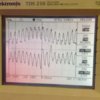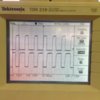All modern pure sinewave inverters use a micro-controller to make the PWM and make some dead time.
Since you are making an old fashioned inverter then maybe dead time does not matter.
Without deadtime the output transistors both turn on for a moment as they switch states which increases the battery current and heats the output transistors. It is most noticeable when the inverter is idling with no load.
Since you are making an old fashioned inverter then maybe dead time does not matter.
Without deadtime the output transistors both turn on for a moment as they switch states which increases the battery current and heats the output transistors. It is most noticeable when the inverter is idling with no load.



